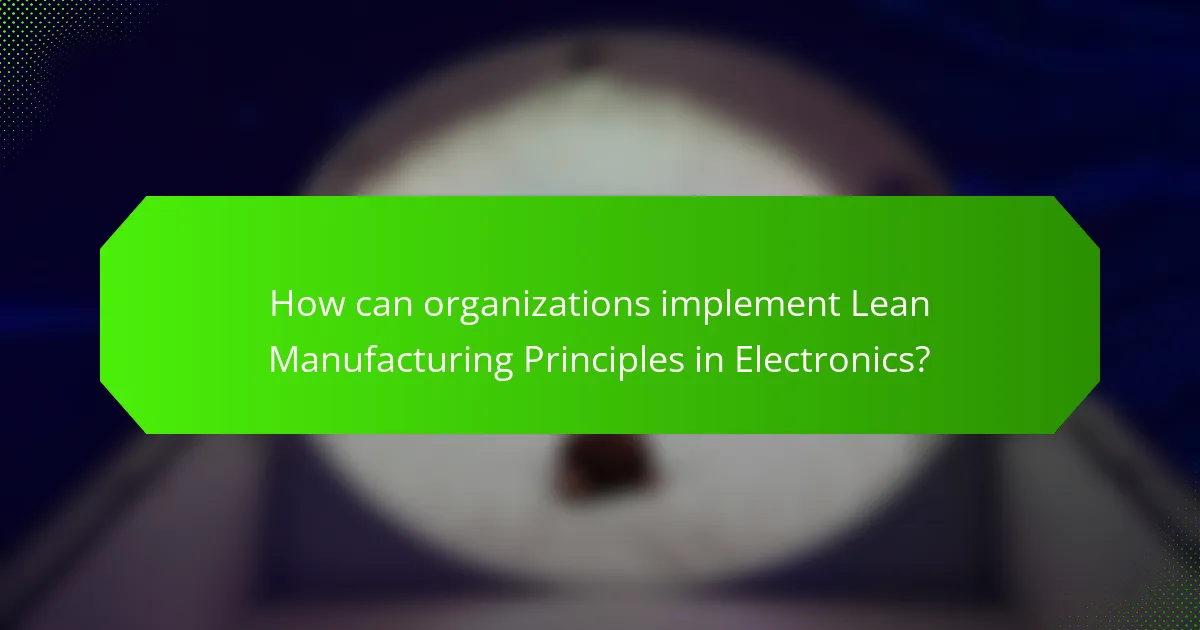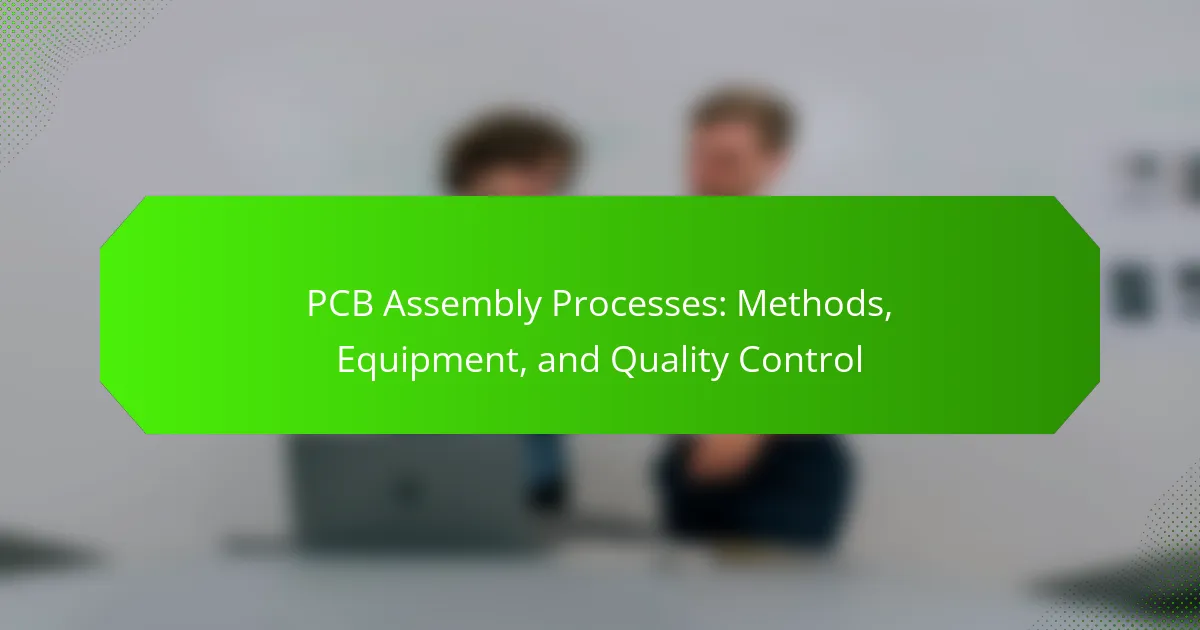Lean manufacturing principles in electronics aim to minimize waste and maximize productivity through strategies such as value stream mapping, continuous improvement, and just-in-time production. Value stream mapping identifies steps in the manufacturing process to eliminate non-value-added activities, while continuous improvement, known as kaizen, fosters ongoing enhancements in efficiency. Just-in-time production reduces inventory costs by aligning production with actual demand. The article outlines strategies for implementing these principles, including employee training, waste reduction, and the establishment of standard operating procedures. Best practices for sustaining lean manufacturing in electronics are also discussed, emphasizing the importance of employee involvement and regular process assessments to enhance productivity and product quality.

What are Lean Manufacturing Principles in Electronics?
Lean manufacturing principles in electronics focus on minimizing waste while maximizing productivity. These principles include value stream mapping, continuous improvement, and just-in-time production. Value stream mapping identifies all steps in a process to eliminate non-value-added activities. Continuous improvement, or kaizen, encourages ongoing enhancements in processes and efficiency. Just-in-time production reduces inventory costs by producing only what is needed, when it is needed. These principles help electronics manufacturers increase efficiency and reduce costs. Implementing lean practices can lead to shorter lead times and improved product quality.
How do Lean Manufacturing Principles apply to the electronics industry?
Lean manufacturing principles streamline production processes in the electronics industry. These principles focus on reducing waste, improving efficiency, and enhancing product quality. For instance, just-in-time (JIT) inventory management minimizes excess stock and reduces holding costs. Value stream mapping identifies areas of waste within manufacturing workflows. Continuous improvement, or Kaizen, fosters a culture of ongoing enhancements in processes and systems.
In the electronics sector, companies often face rapid technological changes and high competition. Implementing lean practices helps them remain agile and responsive to market demands. A study by the Institute of Industrial Engineers found that electronics manufacturers employing lean principles saw a 30% reduction in lead times. This demonstrates the effectiveness of lean methodologies in driving operational excellence.
What are the key characteristics of Lean Manufacturing in electronics?
Key characteristics of Lean Manufacturing in electronics include waste reduction, continuous improvement, and value stream mapping. Waste reduction focuses on eliminating non-value-added activities. This leads to more efficient processes and lower costs. Continuous improvement, or Kaizen, encourages ongoing enhancements in production methods. It involves all employees in identifying areas for improvement. Value stream mapping visualizes the flow of materials and information. This helps identify bottlenecks and areas for optimization. Just-in-time production is also a crucial characteristic. It minimizes inventory levels and aligns production with demand. Overall, these principles enhance efficiency and responsiveness in electronics manufacturing.
How do these principles differ from traditional manufacturing methods?
Lean manufacturing principles focus on minimizing waste and optimizing processes. In contrast, traditional manufacturing often emphasizes maximizing production output. Lean principles prioritize continuous improvement and employee involvement. Traditional methods may rely on standardized processes with less flexibility. Lean manufacturing utilizes just-in-time production to reduce inventory costs. Traditional manufacturing often maintains higher inventory levels to meet demand. Lean methods emphasize value stream mapping to identify inefficiencies. Traditional approaches may overlook such detailed analysis. Lean practices encourage a culture of innovation and adaptability. Traditional manufacturing can be more rigid and resistant to change.
What strategies are used in Lean Manufacturing for electronics?
Lean Manufacturing for electronics employs several key strategies. These include value stream mapping, which identifies and eliminates waste in the production process. Just-in-time (JIT) production minimizes inventory costs by producing only what is needed when it is needed. Continuous improvement, or Kaizen, focuses on incremental enhancements in processes and employee involvement. Standardized work ensures consistent quality and efficiency by establishing clear procedures. 5S methodology organizes the workplace to enhance productivity and safety. Furthermore, visual management tools facilitate communication and transparency in operations. These strategies collectively enhance efficiency and reduce costs in electronics manufacturing.
How can value stream mapping enhance Lean practices?
Value stream mapping enhances Lean practices by visually representing the flow of materials and information. This tool identifies waste and inefficiencies in processes. It allows teams to pinpoint bottlenecks and areas for improvement. By mapping current and future states, organizations can streamline operations. This leads to reduced cycle times and improved quality. Research shows that companies employing value stream mapping see significant reductions in lead times. For instance, a study by Rother and Shook in “Learning to See” emphasizes its role in Lean transformation. Overall, value stream mapping is crucial for effective Lean implementation.
What role does Just-In-Time (JIT) play in electronics manufacturing?
Just-In-Time (JIT) plays a crucial role in electronics manufacturing by minimizing inventory levels and reducing waste. JIT ensures that materials arrive exactly when needed in the production process. This approach leads to lower holding costs and increased efficiency. For instance, companies like Toyota have successfully implemented JIT, resulting in a significant reduction in lead times. Additionally, JIT fosters better supplier relationships and enhances flexibility in responding to market demands. Studies indicate that JIT can improve overall production quality by focusing on just the necessary components. Overall, JIT contributes to a leaner, more responsive manufacturing environment in the electronics sector.
What benefits do Lean Manufacturing Principles provide in electronics?
Lean Manufacturing Principles enhance efficiency, reduce waste, and improve product quality in electronics. These principles streamline production processes by eliminating non-value-added activities. They promote continuous improvement, which leads to faster response times and increased customer satisfaction. Implementing Lean techniques can reduce lead times by up to 50%. Additionally, Lean practices often result in cost savings, with companies reporting reductions in operational costs by 20% or more. Enhanced employee engagement is another benefit, as teams become more involved in problem-solving and process optimization. Overall, Lean Manufacturing Principles significantly contribute to a more efficient and effective electronics manufacturing environment.
How does Lean Manufacturing improve efficiency in electronics production?
Lean Manufacturing improves efficiency in electronics production by minimizing waste and optimizing processes. It streamlines workflows by identifying and eliminating non-value-added activities. This approach leads to faster production cycles and reduced lead times. Lean principles, such as Just-In-Time (JIT) inventory, ensure materials arrive only as needed, reducing excess stock. Additionally, Lean practices enhance quality control, leading to fewer defects. A study by the Massachusetts Institute of Technology found that companies implementing Lean saw a 30% increase in productivity. Overall, Lean Manufacturing fosters a culture of continuous improvement, driving efficiency in electronics production.
What impact does Lean have on product quality in electronics?
Lean manufacturing significantly improves product quality in electronics. It emphasizes waste reduction, which leads to more efficient processes. Streamlined workflows minimize errors and defects during production. Continuous improvement practices foster a culture of quality among employees. By implementing standardized work procedures, consistency in product output is enhanced. Statistical process control is often utilized to monitor quality metrics. This data-driven approach allows for timely adjustments and corrective actions. Companies that adopt Lean principles frequently report higher customer satisfaction due to improved product reliability.

How can organizations implement Lean Manufacturing Principles in Electronics?
Organizations can implement Lean Manufacturing Principles in Electronics by focusing on waste reduction and continuous improvement. They should begin by mapping value streams to identify areas of waste. This process involves analyzing each step in the manufacturing process. Organizations can then prioritize eliminating non-value-added activities. Implementing Just-In-Time (JIT) inventory systems can reduce excess stock and improve efficiency. Training employees on Lean principles fosters a culture of continuous improvement. Additionally, using tools like 5S can enhance workplace organization and productivity. Regularly reviewing processes ensures ongoing adherence to Lean principles. Studies show that Lean implementation can lead to significant cost savings and improved product quality.
What are the steps to successfully implement Lean strategies?
Identify the current state of processes. Conduct value stream mapping to visualize workflows. Engage employees in identifying waste and improvement areas. Set clear goals for Lean implementation. Develop a plan that includes training and resources. Implement changes incrementally to monitor effectiveness. Measure outcomes using key performance indicators. Adjust strategies based on feedback and results.
How can training and employee engagement facilitate Lean implementation?
Training and employee engagement facilitate Lean implementation by enhancing skills and fostering a culture of continuous improvement. Effective training equips employees with the necessary tools and knowledge to identify waste and streamline processes. Engaged employees are more likely to contribute ideas for efficiency and participate actively in Lean initiatives. Research shows that companies with higher employee engagement levels experience 21% greater profitability, which supports Lean objectives. Furthermore, when employees feel valued and involved, they are more committed to implementing Lean practices. This commitment leads to sustained improvements and a more efficient operational environment.
What tools and techniques are essential for Lean implementation?
Essential tools and techniques for Lean implementation include Value Stream Mapping, 5S, Kaizen, and Kanban. Value Stream Mapping identifies and eliminates waste in processes. It visualizes the flow of materials and information. 5S focuses on workplace organization and standardization. It enhances efficiency by sorting, setting in order, shining, standardizing, and sustaining. Kaizen promotes continuous improvement through small, incremental changes. It encourages employee involvement and problem-solving. Kanban manages workflow and inventory levels effectively. It signals when to produce or restock items. These tools collectively enhance productivity and reduce waste in Lean environments.
What challenges might organizations face during implementation?
Organizations may face several challenges during the implementation of lean manufacturing principles. Resistance to change is a common issue, as employees may be accustomed to existing processes. Lack of management support can hinder the necessary commitment for successful implementation. Inadequate training can lead to misunderstandings of lean practices, reducing effectiveness. Additionally, organizations may struggle with aligning lean principles with existing company culture. Limited resources can also restrict the ability to invest in new systems or training. Lastly, measuring progress and outcomes can be challenging without proper metrics in place.
How can resistance to change be managed in Lean initiatives?
Resistance to change in Lean initiatives can be managed through effective communication and engagement. Clear communication about the goals and benefits of Lean practices helps address concerns. Involving employees in the change process fosters ownership and reduces resistance. Training sessions can equip staff with necessary skills, enhancing their confidence in the new methods. Leadership support is crucial; leaders must model the desired behaviors and provide encouragement. Regular feedback loops allow for adjustments based on employee input. Research indicates that organizations with strong change management practices see a 70% success rate in transformation initiatives. Engaging employees and maintaining transparency are key strategies for overcoming resistance.
What are common pitfalls to avoid when adopting Lean practices?
Common pitfalls to avoid when adopting Lean practices include lack of leadership commitment. Successful Lean implementation requires strong support from management. Insufficient training for employees can hinder understanding of Lean principles. Employees must be educated on Lean tools and techniques for effective application. Resistance to change is another significant barrier. Change management strategies are essential to address employee concerns. Focusing solely on tools rather than culture can limit success. A holistic approach that includes cultural transformation is necessary. Neglecting to measure progress can lead to misunderstandings about effectiveness. Regular assessments and feedback loops are critical for continuous improvement. Lastly, failing to engage all levels of staff can result in missed insights. Involvement from all employees fosters a collaborative environment and enhances Lean outcomes.

What are the best practices for sustaining Lean Manufacturing in Electronics?
The best practices for sustaining Lean Manufacturing in Electronics include continuous improvement, employee involvement, and waste reduction. Continuous improvement involves regularly assessing processes for efficiency and effectiveness. Employee involvement ensures that all team members contribute ideas for improvement, fostering a culture of collaboration. Waste reduction focuses on eliminating non-value-added activities in production. Implementing standard operating procedures helps maintain consistency in processes. Regular training sessions keep employees updated on Lean principles. Using value stream mapping identifies areas for improvement in the production flow. Metrics and KPIs should be established to measure progress and success in Lean initiatives. These practices collectively enhance productivity and quality in electronics manufacturing.
How can continuous improvement be integrated into Lean practices?
Continuous improvement can be integrated into Lean practices through systematic methodologies. Techniques such as Plan-Do-Check-Act (PDCA) are essential. PDCA encourages iterative testing and refinement of processes. This method promotes employee involvement in identifying inefficiencies. Regular training sessions enhance skills and awareness of Lean principles. Utilizing tools like Value Stream Mapping identifies areas for improvement. Metrics and key performance indicators (KPIs) track progress and outcomes. Engaging teams in problem-solving fosters a culture of continuous improvement. Research indicates that organizations implementing these strategies see significant productivity gains.
What metrics should be monitored to ensure Lean sustainability?
Key metrics to monitor for Lean sustainability include cycle time, lead time, and overall equipment effectiveness (OEE). Cycle time measures the time taken to complete one production cycle. Reducing cycle time enhances efficiency and responsiveness. Lead time tracks the total time from order to delivery. Shortening lead time improves customer satisfaction and agility. OEE evaluates the productivity of manufacturing equipment. High OEE indicates effective use of resources and equipment. Additionally, monitoring waste levels, such as scrap and rework rates, helps identify areas for improvement. Tracking employee engagement and training effectiveness is also crucial for sustaining Lean practices. These metrics collectively ensure continuous improvement and operational excellence in Lean manufacturing.
What practical tips can help in adopting Lean Manufacturing Principles?
Implementing Lean Manufacturing Principles requires a structured approach. Start by mapping value streams to identify waste. This helps visualize processes and pinpoint inefficiencies. Engage employees at all levels to foster a culture of continuous improvement. Training staff on Lean tools enhances their effectiveness. Utilize 5S methodology to organize the workplace efficiently. This promotes safety and productivity. Regularly review and adjust processes based on performance metrics. Data-driven decisions lead to better outcomes. Establish cross-functional teams to encourage collaboration and innovation. This approach aligns various departments towards common goals. Lastly, maintain a customer focus to ensure that improvements meet client needs.
Lean Manufacturing Principles in Electronics focus on minimizing waste and maximizing productivity through strategies such as value stream mapping, continuous improvement, and just-in-time production. The article outlines how these principles apply specifically to the electronics industry, detailing their key characteristics and benefits, including enhanced efficiency and improved product quality. It also discusses the differences between lean and traditional manufacturing methods, provides insights on implementation strategies, and highlights common challenges organizations may face. Additionally, the article emphasizes the importance of employee engagement and continuous improvement in sustaining lean practices within the electronics sector.



